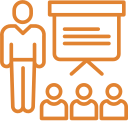Keith Keating’s Story: What Did the Doctor Order?
Recently, speaking with a senior manager in a learning organization, he said to me: “The business is our most important client; they have the money.” Pinching the back of my hand to hold my composure, I took a deep breath before I began the long journey of trying to change their misconstrued viewpoint. In L&D, saying the business is most important because they have the money is analogous to a doctor claiming that the insurance company is most important because they have the money. I recognize some doctors may hold this priority, as do some L&D organizations – but we know neither is correct. Patients should be the most important client and focus for doctors, just as our learners should be our focus and most important client.
The Challenge of Reactive Order-Taking
More often than not, L&D requests do come directly from the business. The requests usually include a murky description of the problem accompanied by a very clear prescription of the solution. A common request might sound something like: “We want a 30-minute web-based training (WBT)” or “Create a two-hour virtual-instructor-led training (VILT).” Having been molded into reactive order-takers, we oblige. After all, the business has the money, and the client “knows” what they want, right? Wrong! I’ve tried this approach with my doctor: I research WebMD.com for my symptoms, read the remedy, and confidently relay this to my doctor, expecting a reward for the time I’ve saved him from doing his job. And yet, each time, he reminds me that he’s the professional, explains how my two-minute research fails in comparison to his 15 years in the medical profession, and warns me how detrimental my self-diagnosis could have been to my health. Allowing our business partners to self-diagnose – and prescribe solutions for our learners – allows them to jeopardize the health or learner experience for our learners.
The Remedy of Design Thinking
Although we would love to respond to the business in the same way my doctor responds to me when I self-diagnose, it’s probably not wise to remind our business partners that we are learning professionals if we want to keep our jobs. So what can we do when the business self-diagnoses and self-medicates on behalf of our learners? One approach we can take is to engage our business partners in co-engineering a remedy that maintains a keen focus on our shared priority – the learner. Design thinking could be just what the doctor ordered! So the next time your business partner self-diagnoses and dictates the remedy for our learners, consider applying the design thinking methodology. Making this recommendation will help you to serve the business as a better partner, ensure the business’s money is well-invested, and refine the focus on our most important client, the learners. After all, whatever the business challenge or performance challenge, it’s the learner we want to impact. Why would we design an experience that fails to serve their needs?
The Power of Design Thinking in L&D
Design thinking is a framework for creative problem-solving. It’s a methodology that focuses on the end user, the learner. Applying design thinking to the L&D setting helps to unlock the users’ needs and problems, even when they don’t know what the problem is or are not able to articulate them correctly (hello, business partners!). Historically, design thinking has been well-known for helping to solve design problems with products. But a lesser-known secret is that design thinking can be applied to problems with services or processes. In fact, design thinking can be applied to a number of challenges around recruitment, performance improvement, employee engagement, and organizational development, just to name a few L&D applications.
Transforming into Solution Partners
Design thinking helps us be better business partners by providing a methodology to follow, evolving L&D from portraying reactive order-takers to proactive solution partners. Rather than accept the problem statement at face value, we empathize with our learners to understand from their point of view the challenges they face. And we maintain that connection with our learners throughout the solution design process.
The Foundation of Empathy
Empathy and understanding are the foundation upon which all design thinking principles rest. Design thinking helps us take a step back and start with problem-finding before moving into problem-solving. When we take orders without doing the due diligence of understanding the problem, we do a disservice to the business by potentially wasting their money. We do an even bigger disservice to our learners by not providing the right remedy to solve their challenges. Design thinking is a structured – but not too rigid – format we can utilize to engage with our business partners and our learners to keep our focus right where it belongs: on the learner.
Keeping the Focus on the Learner
In essence, design thinking serves as a structured yet flexible framework to engage with our business partners and learners, ensuring our focus remains squarely on the learner’s needs. So, the next time a business partner assumes the role of a self-diagnoser and prescribes remedies for our learners, consider recommending the design thinking methodology. This recommendation will empower you to serve as a more effective partner to the business, guaranteeing their investments are worthwhile. Moreover, it will sharpen the spotlight on our most important client – the learners. Ultimately, regardless of the business or performance challenge, it’s the learner we aim to impact. Why, then, would we design an experience that fails to meet their needs?
Using Design Thinking
In the intricate realm of Learning and Development, where learners’ needs should always take precedence, design thinking emerges as the guiding light. It illuminates the path to solutions that resonate with learners while maintaining a harmonious partnership with the business. This approach ensures that the resources invested are channeled effectively, leading to meaningful impacts where it matters most – with the learners.
















